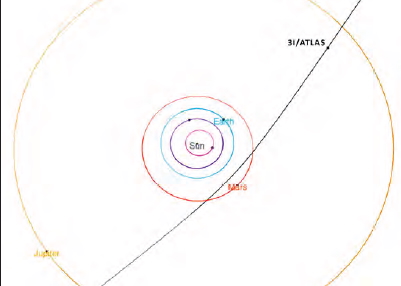Welcome!

HEY, NEIGHBOR — A rare visitor from another solar system is passing through our solar system.
SPACE CALENDAR: Lots of happenings in store for August
ASHEBORO — After a month of hot and humid nights, August has the potential to be a great month for telescope owners in Central North Carolina, if the weather plays nice.
Aug. 6
Conjunction of Saturn and Neptune
On the evening of Aug. 6, Saturn and Neptune will appear very close together in the night sky — an event known as a conjunction.
Though Neptune is too faint to see with the unaided eye, this pairing offers a rare telescopic treat for sky-watchers with access to a good telescope and dark skies.
The two planets will be separated by less than half a degree, allowing them to appear in the same field for much of the night. Saturn will be easy to spot with its iconic rings, while Neptune will appear as a tiny bluish dot nearby.
Aug. 9
Sturgeon Moon (Full)
August’s Full Moon, known as the Sturgeon Moon, will rise on Aug. 9, reaching full illumination at 2:55 p.m. The name originates from the Algonquin tribes and other Indigenous peoples who noted that giant sturgeon in the Great Lakes were most readily caught during this time of year. Other traditional names for this moon include: Grain Moon, marking the time when grain crops are harvested, and the Lightning Moon, a nod to the frequent summer thunderstorms — something we’ve seen plenty of lately.
Aug. 11-13
Perseid MeteorShower peaks
One of the year’s most anticipated meteor showers, the Perseids, will peak the nights of Aug. 11 to 13, producing up to 50 to 100 meteors per hour under ideal dark-sky conditions. The meteors are fast and often leave long, bright trails, making the Perseids a favorite for casual sky-watchers and photographers alike.
This year, a waning gibbous Moon (84% full) will brighten the sky during the peak, washing out fainter meteors. For the best views, watch after midnight, when the moon is lower and the radiant point (where the meteors appear from) is higher in the sky.
Viewing Tips: Find a dark, open location with minimal light pollution. Lie back and let your eyes adjust for at least 20 to 30 minutes. You don’t need a telescope or binoculars — just patience and a wide view of the sky.
A Month for Comets, Backyard Telescopes
Comet 3I/ATLAS — A visitor from another star
Discovered on July 1, 2025, by the NASA-funded ATLAS survey in Chile, Comet 3I/ATLAS is only the third known interstellar object to pass through our solar system. Unlike typical comets, this one is not bound to the Sun by gravity — its hyperbolic path means it’s just passing through our solar system, on a one-time visit from another star system.
Since the discovery, astronomers have tracked its approach using earlier observations going back to June 14 from ATLAS and other observatories. Though it poses no threat to Earth, it will remain visible through backyard telescopes during August, shining faintly as it travels closer to the Sun. The comet will make its closest approach to Earth in early August (about 170 million miles away) before swinging closest to the Sun around Oct. 30.
Because it’s active — showing signs of an icy coma — astronomers have confirmed it’s a true comet rather than a rocky asteroid. Its discovery is a rare chance for scientists to study a visitor from another solar system.
Rare Comet Grouping around Aug. 19
On the evening of Aug. 19, Comet 3I/ATLAS will share the southwestern sky with three other faint comets:
■n C/2025 K1 (ATLAS) — magnitude ~12.
■ P/2010 H2 (Vales) — magnitude ~14.7.
■ C/2021 G2 (ATLAS) — magnitude ~15.6.
3I/ATLAS itself will be near magnitude 14.8. All four will appear within a relatively tight patch of sky after sunset, offering an unusual (but very faint) cluster of comet activity. Observing this event will require a telescope and dark skies.
Solar Maximum ongoing
Solar Maximum is the most active phase in the Sun’s 11-year cycle, marked by an increase in sunspots, solar flares and coronal mass ejections (CMEs). We are currently at or near the peak of Solar Cycle 25, which began in December 2019 and is forecast to peak in mid-to-late 2025 with a predicted sunspot number near 115.
Cycle 25 remains on track to be modest, similar in intensity to Cycle 24 — the weakest in over a century. However, recent months have brought multiple severe geomagnetic storms, with auroras seen as far south as North Carolina in May and October 2024. As of late July, solar activity remains elevated, with sunspots and CMEs continuing to erupt.
Why it matters: Increased solar activity can trigger beautiful auroras but also disrupt satellites, GPS, power grids and radio communications — effects collectively known as space weather.
